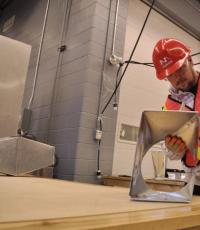Shock wave therapy effectiveness. The blows only make the bones stronger. What is treated with shock wave therapy?
Despite the fact that shock wave therapy (SWT) has been known to medical science for decades, this non-invasive treatment method has been widely used in practice since the 90s of the last century. Initially, UVT was developed as a highly effective and non-surgical method of treatment in sports medicine, but the technique immediately established itself as an effective procedure in the treatment of chronic pain syndrome, to get rid of diseases caused by overstrain of the structures of the musculoskeletal system.
Today, the scope of application of shock wave therapy is far from limited to traumatology and orthopedics; shock wave therapy is used in dermatology and cosmetology, gastroenterology, urology and in the treatment of trophic ulcers and burns.
For some diseases, treatment with shock wave therapy is an alternative even to surgery. In developed countries of the world, this technique is positioned as non-invasive biosurgery, as it makes it possible to achieve profound changes in tissues and directly affects the cause of the disease. SWT can be considered as an effective and non-invasive treatment method that stands between conservative therapy and surgery.

Modern UVT devices are distinguished by excellent efficiency, high safety and cost-effectiveness.
What is the essence of shock wave therapy?
The method is based on short-term exposure to a certain area of high-energy vibration (shock wave). The latter belongs to the infrasound spectrum, that is, its frequency is lower than that which the human ear can detect (less than 16-25 Hz).
Depending on the source of regeneration of such high-amplitude shock waves, electromagnetic, electrohydraulic, piezoelectric and pneumatic UVT devices are distinguished. One of the most reliable and budget options is considered to be a pneumatic device for shock wave therapy.
The biological mechanism of action of UVT is based on the so-called cavitation principle. At the site of inflammation, the permeability of cell membranes changes. Healthy cells are characterized by an elastic membrane with a normal degree of permeability. Cells that take part in the development of the pathological process are distinguished by a tense membrane and poor permeability.

Shock wave therapy has a selective effect: it destroys diseased cells and does not affect healthy ones
The shock wave penetrates the membranes of healthy cells without causing them any harm. If infrasonic waves encounter inflamed cellular elements that are not permeable to the latter, the phenomenon of cavitation develops. Sick cells die. Thus, the shock wave acts selectively on biological tissues.
In turn, cavitation activates a number of biochemical reactions, as a result of which the areas of fibrosis are reabsorbed, blood circulation is activated, the process of release of inflammatory mediators is inhibited, the process of regeneration of damaged tissues, the formation of new blood capillaries, and the restoration of the structure of cartilage, ligaments and bone tissue are started.
Thanks to the action of shock waves, a large number of biologically active substances are produced at the site of inflammation, which block the process of regeneration and transmission of pain impulses, which is why the procedure has an excellent analgesic effect.

Shock wave therapy is excellent for treating heel spur pain.
There are early and late effects of shockwave therapy:
- The early ones include: activation of metabolic processes; improvement of the microcirculation process in tissues; fast pain relief.
- Late ones include: elimination of areas of fibrosis; improvement of blood circulation in the focus of chronic inflammation; stimulation of regeneration processes; restoration of the normal structure of ligaments, bones, cartilage; elimination of chronic pain syndrome.
Indications for use
As mentioned, shockwave therapy is most often used to treat pathologies of the musculoskeletal system:
- plantar fasciitis, or heel spurs;
- muscular-tonic syndromes in pathology of the spinal column;
- tendopathies and ligamentopathies (diseases of tendons and ligaments);
- lateral and medial epicondylitis of the elbow;
- stenosing ligamentitis of the hands;
- humeroscapular periatrosis;
- shoulder impingement syndrome;
- pathologies of the knee, hip, ankle, shoulder, elbow joints;
- chronic bursitis;
- during rehabilitation after bone fractures;
- to eliminate chronic pain due to joint syndrome;
- to eliminate the symptoms of dorsopathy;
- trigger pain syndromes;
- trophic changes in the skin due to diabetes, chronic venous insufficiency, obliterating atherosclerosis.

Shock wave therapy will have a positive effect on any joints in the body
This is not a complete list of indications for the use of shock wave therapy. Perhaps these methods are great and, most likely, the technique will soon find its place in other branches of medicine.
Advantages of UVT
Among the main advantages of treatment with UVT are the following:
- high clinical effectiveness and proven effect;
- rapid onset of results, for example, pain disappears after the first procedure in the course;
- long-term preservation of achieved clinical effects;
- safety and painlessness for the patient;
- non-invasiveness and convenience of shock wave therapy;
- prices for shock wave therapy are relatively low and depend on the size of the treated area; for shock wave therapy of one anatomical area you will have to pay from 350 to 1200 rubles (depending on the level of the clinic and the equipment used);
- a significant reduction in the need to use medications or a complete abandonment of the latter;
- may be a good alternative to painful injections or surgery.

UVT does not require any preparation from the patient and can be performed on an outpatient basis at a convenient time.
Limitations in treatment
Despite the high safety of the technique, there are several contraindications to UVT:
- pregnancy;
- childhood;
- malignant tumors of any location;
- blood clotting disorders;
- acute infectious disease;
- the patient has a pacemaker;
- grade 3 hypertension, tendency to develop hypertensive crises;
- pustular skin lesions in the area of exposure to UVT.
SWT procedure
Conducting a shock wave therapy session is very simple to perform and does not require special preparation. Sessions take place on an outpatient basis and do not take much time.
For shock wave therapy, the patient is positioned comfortably on a couch. The doctor pre-treats the required areas of the skin with a special gel. Next, the specialist sets the necessary settings for the device (depending on the diagnosis) and presses the sensor tightly to the area of the body. One session can last 5-30 minutes. As a rule, the entire course of treatment includes 7-10 procedures with an interval of 4-7 days.
Thus, shock wave therapy is a modern and highly effective way to treat many diseases of the musculoskeletal system and more. When used correctly, a positive result is observed in almost 95% of cases, but it is very important to correctly take into account all the indications and contraindications for this method of treatment.
Or UVT is a relatively new method of treating diseases of the musculoskeletal system. In recent years, it has been positioned as an alternative to surgery, since it carries fewer risks for the patient and does not require hospitalization and long-term rehabilitation. However, the safety of the SWT method depends on compliance with many conditions.
What is the UVT procedure?
The essence of the method is the impact on tissues of a shock-acoustic wave of a special frequency generated by the UVT apparatus. Shock waves are infrasonic pulses characterized by very high pressure. The shock wave can affect tissue, stimulating microcirculation and regeneration processes. Due to this, pain is reduced, blood circulation at the site of exposure is increased, decalcified areas of the joints are loosened with subsequent resorption of fragments, and the removal of salts from places of their deposition is activated. A local increase in tissue temperature accelerates regenerative processes and prevents the development of inflammation.
How is shock wave therapy done? From the patient's point of view, the SWT procedure looks very simple. For better conductivity, a special gel is applied to the surface of the skin at the site of the disease, as when exposed to ultrasound. After this, the doctor uses a device to work on this area of the body for a certain time. The parameters of the wave pressure and its frequency indicated for the treatment of a specific disease are previously set on the UVT device.
Indications for shock wave therapy
Shock wave therapy, like any type of medical intervention, has its own indications. This method has proven itself especially well in the treatment of certain diseases of the musculoskeletal system. The positive effect is proven by the results of scientific research. In traumatology and orthopedics, shockwave therapy is recommended for the following diagnoses:
- arthrosis at an early stage of development, arthritis and synovitis of non-infectious origin;
- heel spur (plantar fasciitis);
- Tennis elbow (epicondylitis);
- bursitis, achillesitis, achillodynia;
- osteochondrosis of the spine, intervertebral hernias (special care should be taken when treating intervertebral hernias with SWT!);
- pain in the coccyx area associated with injuries;
- glenohumeral periarthritis or “frozen shoulder”;
- “youthful osteochondrosis” (osteochodropathy);
- soft tissue injuries with muscle ruptures and partial ruptures of tendons and ligaments;
- rehabilitation after surgical interventions to develop joints;
- stimulation of callus formation in slow-healing and non-healing fractures;
- relieving muscle tension and spasms resulting from intense sports training.
Efficiency of the method
The effectiveness of using shockwave therapy has been confirmed by a number of clinical trials. With the correct diagnosis and determination of the strength and frequency of the impact wave, patients experience lasting positive effects - both early and long-term.
Early effects symptoms that appear immediately after the procedure:
- improvement of microcirculation in tissues;
- local anesthesia;
- acceleration of metabolism;
- reduction of muscle hypertonicity.
TO long-term effects UVT includes the following:
- loosening microcrystals of calcium salts and removing them from the body;
- restoration of mobility of ligaments and joints;
- enhancing tissue regeneration;
- proliferation of microcapillaries and restoration of blood supply to tissues;
- long-term activation of blood flow in the affected areas.
The UVT method is particularly effective in the treatment of so-called heel spurs, as well as arthritis outside the acute phase and arthrosis in the initial stages. With an integrated approach, including drug therapy, massage, exercise therapy and adherence to work and rest, complete cure is achievable in 80–90% of cases.
Before prescribing shock wave therapy to a patient, the doctor must carefully review the patient’s medical history and, if necessary, refer the patient for additional examination. This is done in order to exclude factors that are contraindications to the procedure.
Contraindications to UVT therapy can be divided into two large groups: conditional and unconditional.
So called conditional, or temporary, contraindications:
- pregnancy at any stage, since exposure to shock wave therapy can potentially lead to miscarriage or pathologies of fetal development;
- childhood and adolescence - after the patient reaches 17–20 years of age, shockwave therapy may be indicated;
- acute infectious diseases;
- deformation of the musculoskeletal system, which does not allow the disease area to be exposed to shock wave therapy.
Unconditional UVT contraindications in turn are divided into technical and general somatic.
Technical contraindications:
- effects on large (main) vessels, lung tissue, spinal cord or brain, intestines;
- impact on the spine (in a number of cases);
- the presence of a pacemaker: the use of shockwave therapy is prohibited only on devices with an electromagnetic component, while the use of pneumatic devices will not harm the operation of the stimulator.
General somatic contraindications shock wave therapy:
- oncological diseases;
- bleeding disorders;
- cardiac arrhythmias;
- diseases of the nervous system.
What harm can UVT cause?
"Do no harm". This is the main principle of medicine that every doctor should follow. Patients should not perceive UVT as a panacea and expect that it can cure any disease.
The mechanisms of the effect of shock wave therapy on the human body have not yet been fully elucidated, therefore, the procedure should be prescribed and carried out only by a qualified specialist who is fluent in the methods of shock wave therapy and has high-quality equipment. Otherwise, instead of a therapeutic effect, irreparable harm may be caused to health.
Treatment using the UVT method at the ZDOROVE+ clinic
The specialty of the Health+ clinic is shock wave therapy. Based on modern developments in this area and taking into account all indications and contraindications, the clinic’s specialists provide early diagnosis and effective treatment of diseases of the musculoskeletal system.
“Health+” offers a course of treatment for heel spurs (plantar fasciitis), arthritis, arthrosis, joint pain, some types of osteochondrosis, cellulite (gynoid lipodystrophy). The use of high-tech equipment and the qualifications of doctors allows us to effectively carry out UVT of intervertebral hernias in the clinic. This type of therapy is considered the most complex, requiring special precision of exposure and selection of frequency, focus and wave energy.
Prices for treatment with the UVT method at the Health+ medical center are among the lowest in Moscow, which makes therapy accessible to a wide range of patients.
Special sound waves began to be used to treat pathologies of the musculoskeletal system quite recently. Nevertheless, the results obtained over the entire period of their use indicate the high efficiency of this technology. Find out in more detail what this method is and why it is needed.
What is shock wave therapy
This technique was developed from lithotripsy, widely used in urology. Extracorporeal shock wave therapy (ESWT) is based on the principle of cavitation, as well as the acoustic impedance of the cartilage and bone structures of the human body. Clinical trials have shown that the method has a positive effect on other tissues of the body.
The shock wave in medicine has become so widespread due to its special healing effect. The latter lies in the fact that low-frequency radiation is capable of breaking up solid calcified formations encountered in its path without harm to healthy tissue. At the end of the procedure, these pathological accumulations, as a rule, completely resolve. It is important to note that the technique is ineffective against malignant neoplasms.
Shock wave therapy - indications
Low-frequency sound vibrations are used in the treatment of a wide variety of musculoskeletal pathologies. The wave shock method also helps fight many urological problems. Thus, ESWT is indicated for erectile dysfunction. In addition, this non-invasive procedure is used in the complex treatment of ailments that previously required exclusively surgical treatment: herniated discs and advanced popliteal tendonitis. In general, the use of shock wave therapy has the following indications:
- intervertebral hernia;
- avascular necrosis;
- arthrosis;
- Achilles tendinitis;
- pain after endoprosthetics;
- pain when rotating the shoulder;
- valgus deformity of the toe;
- knee chronic tendinitis;
- inflammatory processes of non-infectious nature;
- a bone on the foot;
- false joints;
- plantar fasciitis;
- osteocondritis of the spine;
- healing of bones after fractures;
- tendinosis;
- revascularization of damaged areas of the vascular network;
- rehabilitation after muscle and ligament injuries;
- epicondylitis;
- foot ulcers.
Shock wave therapy treatment
For many diseases, low-frequency sound waves are used as a good alternative to surgery. During treatment with shock wave therapy, the penetrating ability of cell membranes increases, which helps to activate regeneration processes in the affected area. In addition, under the influence of UHT, cavitation bubbles form, which, when bursting, create a counterforce directed against calcific formations.

Shock wave therapy device
A significant advantage of such devices is the possibility of outpatient SWT. Modern shock wave therapy devices are effective and have a high level of safety. One of the most budget-friendly options is considered to be a pneumatic device for ESWT. This device, like its other analogues, generates waves in the ultrasonic spectrum. Such characteristics help the device influence the course of cavitation processes in the cell. Depending on the source generating the shock wave, devices are distinguished:
- electromagnetic;
- electrohydraulic;
- piezoelectric;
- pneumatic.
Shock wave therapy procedure
Conducting a UVT session does not require any special preparation from the patient. The shock wave therapy procedure is performed in an outpatient setting. The patient lies on the couch. Before the session, the specialist sets up the UVT device in the mode required for a specific diagnosis. A special gel is first applied to the problem area, after which the sensor is pressed tightly against the body. The duration of the procedure is 7-25 minutes. The course of treatment includes about 10 sessions, which are carried out at 4-6 day intervals.
Shock wave therapy - contraindications
- Foot joints: treatment and features of foot diseases
- Treatment of coxarthrosis of the hip joint with medications and folk remedies, surgery and exercises
- Vacuum weight loss machine - results with before and after photos. Contraindications for exercising on a barosimulator
The UVT procedure has some limitations. Contraindications to shock wave therapy mostly relate to oncology and diabetes. It is important to say that pregnancy is also considered an obstacle to prescribing ESWT. Questions often arise among patients about the permissibility of treating bone necrosis using shock wave therapy. Experts say that this diagnosis is not a contraindication for the procedure. Meanwhile, doctors strongly do not recommend doing shockwave therapy for the following conditions:
- blood clotting disorders;
- implanted pacemaker;
- acute infectious process;
- angina pectoris.

Where is shock wave therapy performed?
You can undergo the UVT procedure in specialized private physiotherapy clinics. Before visiting one of these medical institutions, read patient reviews about the quality and cost of the services provided there. Recently, shock wave therapy has been carried out in many rehabilitation centers and sanatoriums. UVT sessions can be easily carried out at home. To bring this idea to life, you will need to purchase the appropriate technical equipment.
Devices for UVT are sold in specialized medical equipment stores. It should be said that prices for such products are often unreasonably inflated. It is important for the consumer to know that a reliable device for shock wave therapy can be purchased inexpensively in an online store by pre-ordering it from the photo catalog presented on the website.
Price for shock wave therapy
The cost of the SWT procedure depends on the nature of the disease and the number of sessions required for cure. The duration of the course, as a rule, is determined purely individually for each patient. In addition, the cost of shock wave therapy in different clinics is determined taking into account the class and level of technical equipment of the latter. Thus, prices for shock therapy for some diseases are presented in the table below:
Pathology | Cost (r.) |
Intercostal neuralgia | |
Arthritis/arthrosis | |
Osteochondrosis | |
Heel spur | |
Radiculitis |
Find out in other ways.
Video: what shock wave therapy treats

Today's medicine has the capabilities to make surgery take a back seat. Hardware methods of influence give excellent results.
These methods include shock wave therapy, which is becoming increasingly popular. It is used in orthopedics, sports and aesthetic medicine, and is part of a complex of rehabilitation measures. The scope of its application is very wide.
Operating principle of UVT
An advanced and effective method of influencing the body, it is based on the properties of sound (acoustic waves) - this is shock wave therapy (SWT).
The specialists who created it believe that shockwave therapy is at the intersection of conservative and surgical therapy. It has a positive effect in the treatment of the musculoskeletal system and a number of other pathologies.
Treatment is carried out using a special device capable of creating low-frequency sounds (infrasound) that are inaudible.
The acoustic wave at the point of influence of the device moves through the tissues of our body. When it reaches dense tissue, its movement stops.
The method is simple and accessible, the patient does not need to specially prepare for the session, which is why today it has become so widespread. After the initial procedure, the patient feels much better.

The procedure and its effectiveness are based on the difference in acoustic resistance of hard and soft tissues of the body.
Waves, penetrating through the skin, fatty tissue, and blood vessels, find resistance where the structures are more solid: muscles, ligaments, bones.
In these areas, an effect similar to an intense massage occurs:
- lymph flow and blood flow increases;
- muscles that are toned relax;
- formations close to pathology are destroyed: growths on bones, salt deposits;
- The sensitivity of the nerve endings decreases, the patient does not feel pain.
This effect of UVT makes it possible to get rid of a number of diseases in complex therapy, using additionally other treatment methods.
Already during the initial session, a person feels a rush of blood where the device works, the pain disappears, and the general condition improves.
How does the procedure work?
UVT is implemented on an outpatient basis, in a physiotherapy room. You must arrive at the appointed time with documents of medical examinations performed and prescribed by your doctor.
A physical therapist will review test results, examine the affected area, and select an appropriate treatment regimen.
The essence of the treatment is as follows: a gel is applied to the treatment area, the tip of the UVT device is applied to the skin surface, and the treatment procedure (session) begins. The patient may feel slight discomfort and short pain impulses.

Session duration is 15-20 minutes. In some cases, after it is performed, redness of the skin is observed, and the feeling of pain is similar to pain after active physical activity.
The next session is scheduled after 3-7 days. Then the sessions are repeated 3-5 times at equal intervals. It is recommended to repeat the course every six months to a year to obtain positive results.
After completion of treatment, patients feel:
- relief of pain and swelling;
- greater mobility in damaged joints;
- shorter recovery period after fractures or injuries;
- rapid adaptation to physical activity;
- weakening of inflammatory processes;
- increasing the strength of fabrics.
According to orthopedic doctors, the use of the UVD method gives a good effect without complications. If the procedure schedule is completed, then 90-95% of patients experience persistent positive dynamics in their physical condition.
There are examples where, thanks to this method, it was possible to avoid surgical intervention, which requires subsequent long-term treatment.
Indications for the use of UVT
The shock wave therapy procedure is largely aimed at helping to treat the musculoskeletal system.
This method is effective in the following cases:
- : heel pain that gets worse with exercise. The occurrence of pain is associated with inflammatory processes in the plantar fascia (ligaments connecting the bone to the toes);
- Epicondylitis: inflammation of the tissue in the elbow joint. Develops gradually. Typical for middle-aged people;
- Osteochondrosis: damage to the intervertebral discs. There is compression of the spine, which puts pressure on the discs located between the vertebrae;
- Osteoarthritis: chronic disease of the joints and articular cartilage;
- Achillodynia: the Achilles tendon is affected, resulting in reduced motor activity;
- Tendinosis, bursitis, synovitis, ligamentosis: inflammatory processes in the periarticular bursae;
- Humeral-scapular periarthropathy: pain and limitation of movement in the shoulder joint;
- Coccydynia: the occurrence of pain in the coccyx area associated with inflammation of the branches of the coccygeal nerves. More common in women;
- Muscular-tonic syndrome: occurs due to muscle spasm that occurs due to a disease of the spine;
- Slow healing;
- False joints: pathology associated with disruption of the continuity of the tubular bone and mobility in those sections where it should not exist;
- Pain as a result of prosthetics, injuries;
- Flat feet.
In addition to the listed diseases, the device helps with the presence of stones in the kidneys and gall bladder, with trophic ulcers, cellulite and fat deposits. The number of diseases in which shock wave therapy is used is quite impressive.

The outcome of the impact of UVT gives hope for recovery. Ligaments and tendons can more easily withstand physical activity and become less susceptible to injury, deposits in fatty tissue disappear, and the skin is renewed.
Due to the effect of UVT, microcracks appear on the bones, due to which the regeneration of bone tissue is enhanced. Joints become more mobile thanks to shock wave joint therapy.
Contraindications
Compared to the positive and extensive impact of UVT, there are not so many contraindications, but they cannot be neglected:
- availability does not allow the use of this method;
- if a pacemaker is built into the heart muscle, because acoustic waves can disrupt its rhythm;
- the presence of an infectious disease during the treatment stage;
- pregnancy;
- fragility of blood vessels and problems associated with blood clotting;
- age category – up to 18 years.
When prescribing UVT, consultation with a specialist is mandatory. You may have specific contraindications for treatment with this device.
Conclusion
Shock wave therapy, the indications and contraindications of which we have reviewed, is a progressive, modern method of medicine.
This means that the method can help many people literally “get back on their feet”: move actively, work, solve everyday problems, and even play sports.
But do not forget that treatment should be prescribed by a specialist. Only then will it be beneficial.
Video: Shock wave therapy




